Nvidia GeForce GTX 1080 Pascal Review
Ashes Of The Singularity, Battlefield 4 And GTA V Results
Ashes Of The Singularity
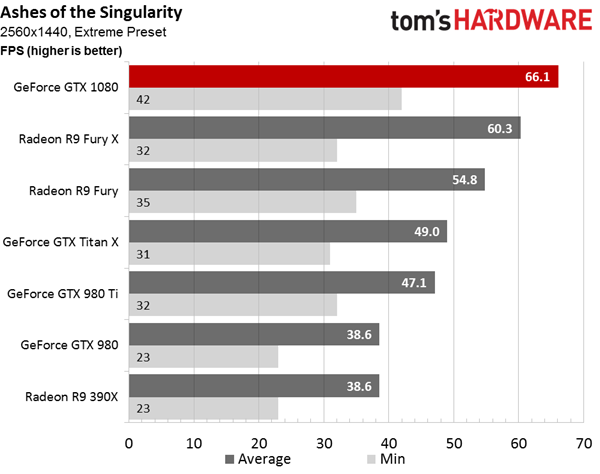
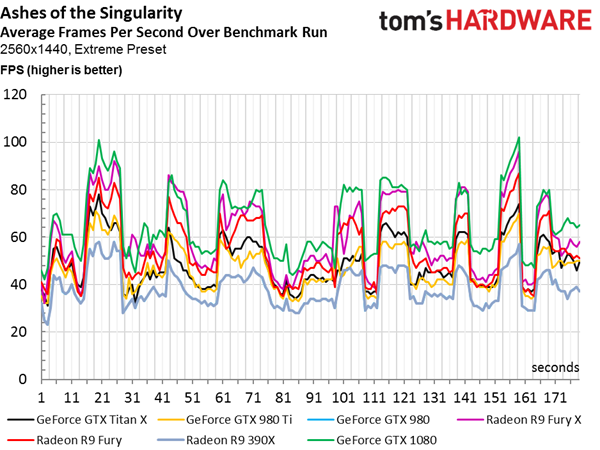
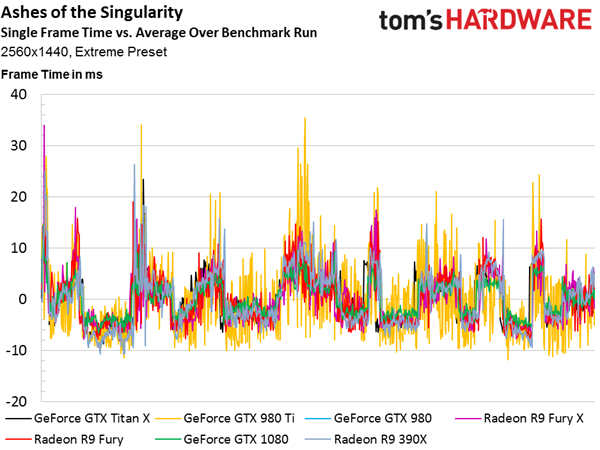
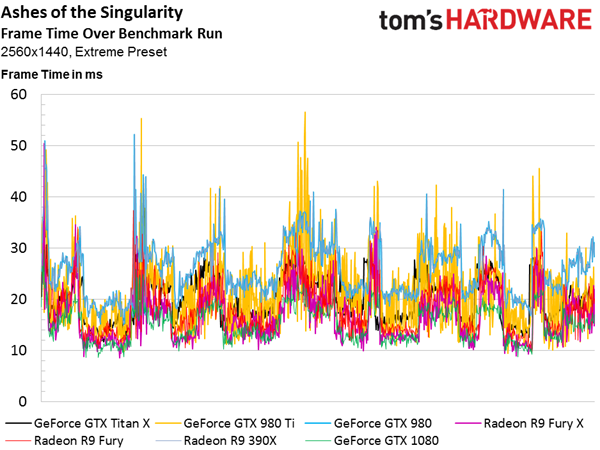

Prior to its GeForce GTX 1080, Nvidia’s fastest gaming cards were beaten soundly by AMD’s Radeon R9 Fury X and Fury in the Ashes benchmark. It takes GP104 to claw back a victory, though the GTX 1080’s lead isn’t particularly impressive for a new flagship on a new architecture built with a new process node. Most notable is that the 1080’s minimum frame rate is 10 FPS higher than the Fury X’s.
The 1080 does appear to have a big impact on smoothness (variance in frame-to-frame delivery) compared to Nvidia’s Maxwell-based cards in Ashes. GeForce GTX 980 Ti, in particular, demonstrates a number of frame time spikes that aren’t apparent in frame rate over time, but do manifest as hitching on-screen.

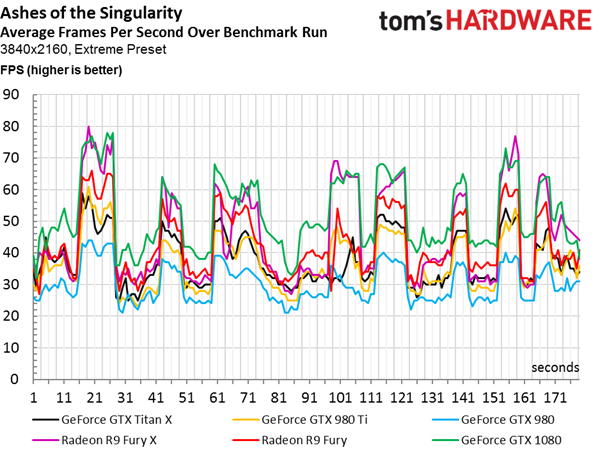
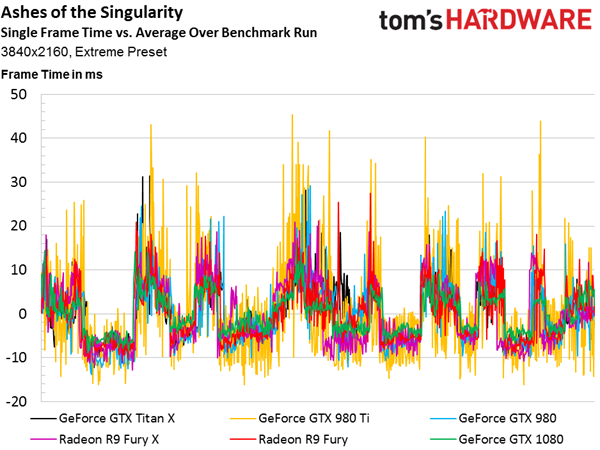


GeForce GTX 1080 holds onto its lead at 3840x2160, while both Fiji-based boards trounce Nvidia’s previous-gen hardware. The 980 Ti’s frame-to-frame variance issues are still clear to see, though we also see the Titan X popping up behind those yellow spikes as well. Meanwhile, the GTX 1080 exhibits very little of the judder that’d indicate inconsistent frame delivery.
Battlefield 4
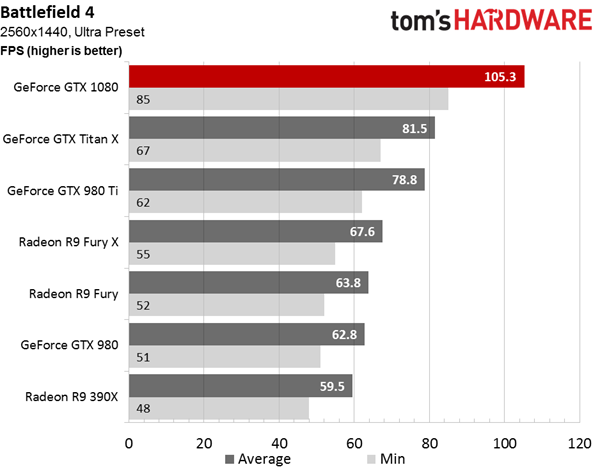


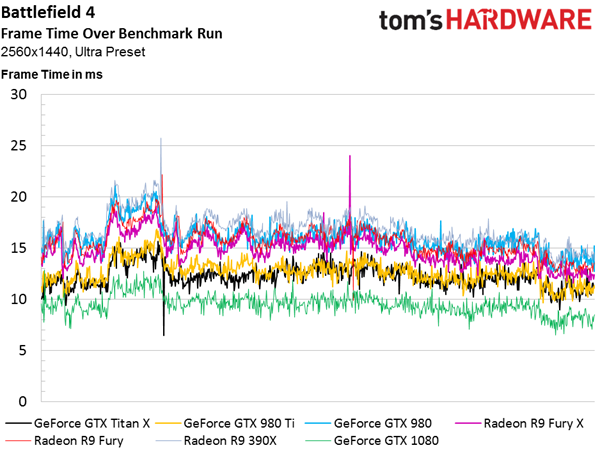

Nvidia’s GeForce GTX 1080 is almost 68% faster than the older GeForce GTX 980, and it’s almost 34% faster than the 980 Ti. No wonder the company is asking $700 for it. But at least in Battlefield 4 at 2560x1440, you don’t need to spend that much money for a good experience. All the way down to a Radeon R9 390X, it’s possible to average around 60 FPS and enjoy low frame time variance.
Let’s step up to 4K to see if more resolution can tax any of these cards in a meaningful way.


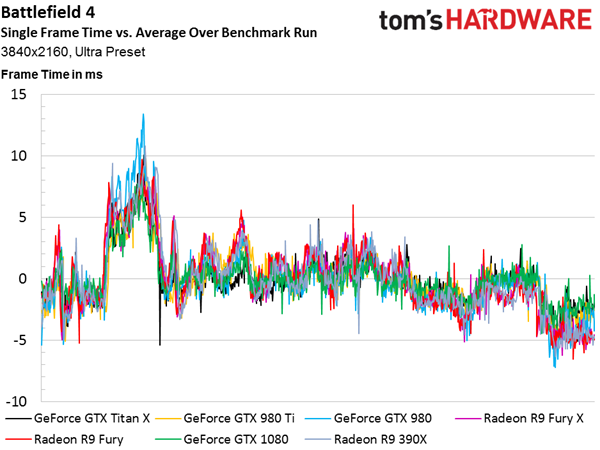
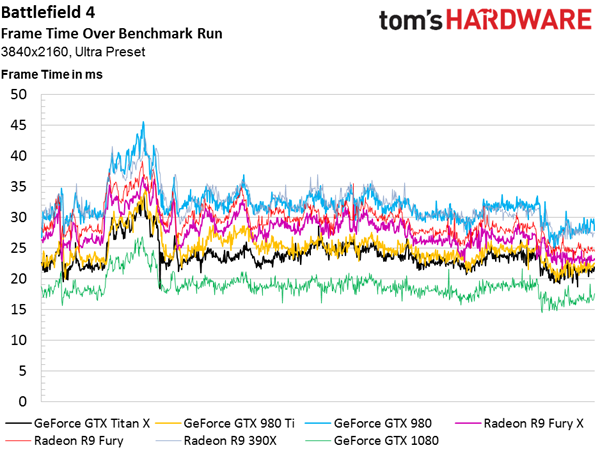
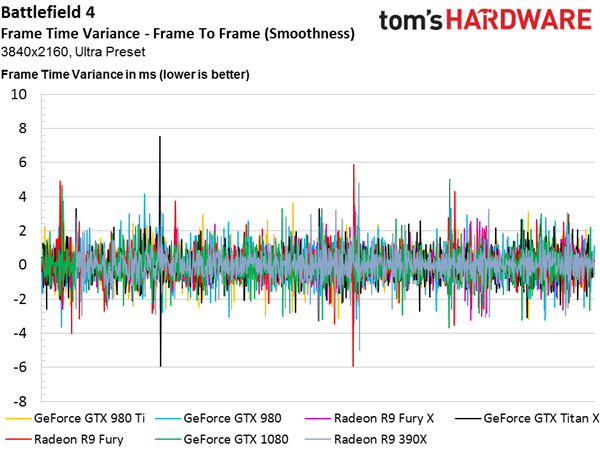
There’s not much else AMD or Nvidia can do to optimize their drivers for Battlefield 4—even at 4K, all of these cards facilitate smooth frame delivery. And while we’re not in love with average frame rates in the 30s or 40s, you could conceivably play at 3840x2160 on a GeForce GTX 980 Ti or Radeon R9 Fury X.
The thing is, both companies really wanted those previous-gen cards to be the first single-GPU solutions for 4K. And if you turned down certain detail settings, they were. But enthusiasts want to enjoy PC games with their quality sliders cranked up. By beating its GeForce GTX 980 Ti by almost 33%, Nvidia does make Battlefield 4 enjoyable at 4K using the Ultra preset. But does that generalization apply to newer, more taxing titles? Or are you still looking at a dual-GPU setup for fast-enough frame rates?
Get Tom's Hardware's best news and in-depth reviews, straight to your inbox.
Grand Theft Auto V
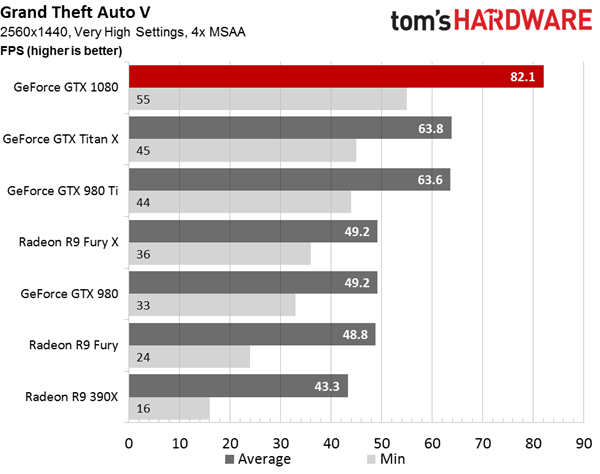


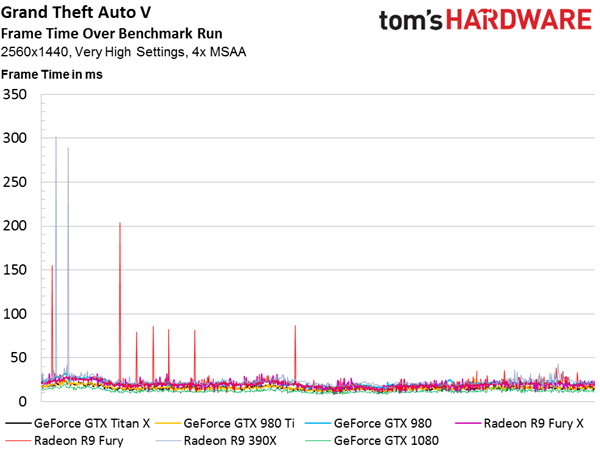

Nvidia hardware dominates in Grand Theft Auto, as the GeForce GTX 1080 is about 67% faster than the GeForce GTX 980 and Radeon R9 Fury X.
Interestingly, the Radeon R9 Fury and 390X—both from AMD add-in board partners—demonstrate sharp frame time spikes that show up as hitching during playback. The reference Radeon R9 Fury X doesn’t exhibit the same behavior.





Stepping up to 4K with the quality settings we’re using has a big impact on performance. Four of seven cards average less than 30 FPS, and two of those remaining still post minimum frame rates just north of 20 FPS. A greater-than 31% advantage over the GeForce GTX 980 Ti makes Nvidia’s 1080 the only card we’d consider in a single-GPU setup for these detail settings.
Current page: Ashes Of The Singularity, Battlefield 4 And GTA V Results
Prev Page How We Tested Nvidia's GeForce GTX 1080 Next Page Hitman, CARS And Rise Of The Tomb Raider Results-
JeanLuc Chris, were you invited to the Nvidia press event in Texas?Reply
About time we saw some cards based of a new process, it seemed like we were going to be stuck on 28nm for the rest of time.
As normal Nvidia is creaming it up in DX11 but DX12 performance does look ominous IMO, there's not enough gain over the previous generation and makes me think AMD new Polaris cards might dominate when it comes to DX12. -
slimreaper Could you run an Otoy octane bench? This really could change the motion graphics industry!?Reply
-
F-minus Seriously I have to ask, did nvidia instruct every single reviewer to bench the 1080 against stock maxwell cards? Cause i'd like to see real world scenarios with an OCed 980Ti, because nobody runs stock or even buys stock, if you can even buy stock 980Tis.Reply -
cknobman Nice results but honestly they dont blow me away.Reply
In fact, I think Nvidia left the door open for AMD to take control of the high end market later this year.
And fix the friggin power consumption charts, you went with about the worst possible way to show them. -
FormatC Stock 1080 vs. stock 980 Ti :)Reply
Both cards can be oc'ed and if you have a real custom 1080 in your hand, the oc'ed 980 Ti looks in direct comparison to an oc'ed 1080 worse than the stock card in this review to the other stock card. :) -
Gungar @F-minus, i saw the same thing. The gtx 980Ti overclocks way better thn 1080, i am pretty sure OC vs OC, there is nearly no performance difference. (disappointing)Reply -
toddybody Reply@F-minus, i saw the same thing. The gtx 980Ti overclocks way better thn 1080, i am pretty sure OC vs OC, there is nearly no performance difference. (disappointing)
LOL. My 980ti doesnt hit 2.2Ghz on air. We need to wait for more benchmarks...I'd like to see the G1 980ti against a similar 1080. -
F-minus Exactly, but it seems like nvidia instructed every single outlet to bench the Reference 1080 only against stock Maxwell cards, which is honestly <Mod Edit> - pardon. I bet an OCed 980Ti would come super close to the stock 1080, which at that point makes me wonder why even upgrade now, sure you can push the 1080 too, but I'd wait for a price drop or at least the supposed cheaper AIB cards.Reply -
FormatC I have a handpicked Gigabyte GTX 980 Ti Xtreme Gaming Waterforce at 1.65 Ghz in one of my rigs, it's slower.Reply
